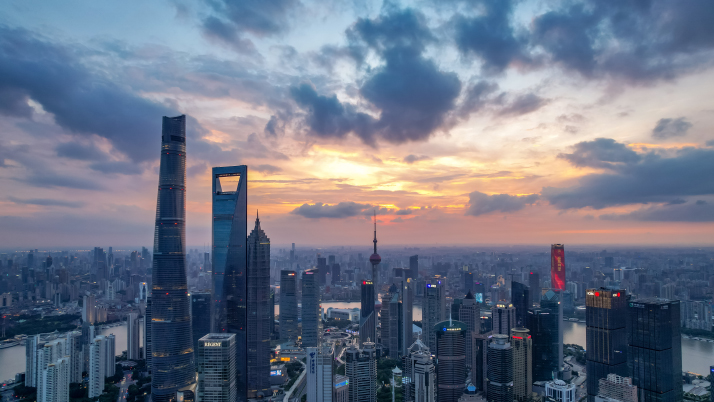
The 632-meter Shanghai Tower easily puts to shame other skyscrapers in China ever since its construction was finished in 2015. Sitting on the Huangpu River bank in Shanghai, it is currently the world’s third highest.
Where the next new super-tall construction would come out in China has since been a question on many lips as several cities announced their ambitious plans for erecting their own (even taller) landmarks.
But on July 12, a ban released by the National Development and Reform Commission (NDRC) on the construction of buildings over 500 meters tall put a definitive halt to the height race. The ban also strictly limits the construction of buildings taller than 250 meters and requires that any building over 100 meters must match the spatial scale of the city it’s in and commensurate with local fire and rescue response capabilities.
High-rises
This wasn’t the first time China issued such a ban. In April 2020, the NDRC announced a regulation on restricting the construction of skyscrapers over 500 meters. In July 2021, the commission lifted this restriction to an official ban.
Long Weiding, a professor at Shanghai-based Tongji University who has long been engaged in the study of energy-efficient buildings and environmental management, told China Newsweek that before releasing the restrictions, he and several other experts had attended a meeting to offer their suggestions on related measures.
“All experts at the meeting suggested limiting the number of super-tall buildings, as the disadvantages of these constructions far outweigh their advantages,” Long said.
The skyscrapers, once considered a sign of economic prosperity, have become somewhat of a tool for cities to outcompete one another.
Wuhan, capital city of Hubei Province in central China, planned to outdo the Shanghai Tower by building a 636-meter tower of its own; Chengdu, capital of Sichuan Province in southwest China, voiced the same intention and decided it would be constructing a 677-meter one; Suzhou, a city in Jiangsu Province of east China, had even more ambitious plans: a 729-meter tower.
Li Xun, a senior engineer on urban planning from the China Academy of Urban Planning and Design, echoed Long’s words. “Some cities blindly erected tall buildings without even considering whether these would fit into their urban context,” Li said. “And to attract attention, some developers and urban planners went to the extremes of novelty—and even eccentricity.”
Among the world’s top 100 tallest completed buildings, about half are in China, according to the data of the Council on Tall Buildings and Urban Habitat (CTBUH), a Chicago-based non-profit organization.
High costs
Getting a solid return on investment has proved extremely challenging for these buildings and their high vacancy rates have only aggravated the situation. “The vacancy rate of many tall office buildings has now reached 30 percent, in some places even 50-plus percent,” Li said.
Other structures have just been left unfinished as developers couldn’t get enough money to complete them in time.
Goldin Finance 117 in Tianjin is one example of the latter. With an investment of roughly 70 billion yuan ($10.3 billion), it aimed to be China’s third tallest tower with a designed height of 596.5 meters. But even though construction first started in 2008, it has yet to be finished.
Information from the CTBUH shows that as of May this year, China had 81 tall buildings under construction; among them, 66 were left uncompleted.
This has impacted many a developer’s motivation to get involved in these types of projects and since 2016, the management and sustainability of high-rises have become a central government concern.
Many factors, including deeper foundations and longer construction timelines, have largely increased the cost of erecting these giants.
The Shanghai Tower, with 128 floors, cost about 15 billion yuan ($2.2 billion) and construction spanned eight years—from breaking ground to completion. The soft and wet soil made it very difficult to lay down a concrete foundation at more than 30 meters below ground level with over 900 bore piles.
But the construction cost is just the beginning. The maintenance and operation fees of these structures are also much higher than those of their normal-sized counterparts. As most of the buildings are fully enclosed, their energy consumption for heating and air-conditioning is much higher than that in lower ones.
“The energy consumption of super-tall buildings is 30 percent higher than that in normal structures,” Long said.
High risks
Their height also makes them more vulnerable to strong winds and earthquakes. In May 2021, SEG Plaza, a 355-meter skyscraper in Shenzhen, Guangdong Province, started shaking, sending shoppers and office workers scrambling for safety. The culprits included strong winds, subway operations, and rising temperatures. Following the scare, the building was closed for four months to undergo inspection and maintenance.
Another crucial issue is that it can prove more difficult for tall buildings to possess adequate emergency preparedness, like in the event of a fire.
Jiang Dining, a member of China Fire Protection Association, revealed that rescue response for tall structures is a tricky topic given the maximum height firefighting trucks can handle is just over 100 meters. Smoke rises vertically at a speed roughly 10 times that of its horizontal diffusion, quickly rendering it impossible for people on higher floors to make their way down.
In many cases, people inside these tall marvels only have built-in automatic fire-fighting facilities to rely on—or firefighting helicopters.
Moreover, the lifespan of these structures is usually shorter than that of normal-sized buildings and renovating them as they age can see costs go through the roof.
The super-tall construction craze does not align with China’s green development philosophy and needs to be tackled at the root, Huang Yan, Vice Minister of Housing and Urban-Rural Development, said.
Source: Beijing Review, No.32 August 11, 2022. http://www.bjreview.com.cn/China/202208/t20220808_800303100.html
Leave a Reply
You must be logged in to post a comment.